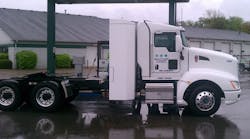The lower cost of fuel for natural gas-powered highway tractors compared to their diesel-fired brethren could make it more profitable for trucking companies to engage in longer lengths of haul for intermodal shipments.
That’s the viewpoint Jason Kuehn, an associate partner with transportation/railroad consulting firm Oliver Wyman and 20-year railroad industry veteran, expressed during a conference call sponsored by Wall Street investment firm Stifel Nicolaus & Co. last Friday.
“If NG [natural gas] powered tractors win this battle against the clock, the break-even distance for intermodal economics to win could jump from the approximately 500 to 600 miles today to 700 once the truckers achieve critical mass with the application of NG engines,” he said.
Kuehn said that puts the railroads under some competitive pressure to develop NG-fired locomotives themselves, though one of the issues to be resolved before the railroads will be able to run on natural gas involves a federal safety rule currently prohibiting the location of a NG tender car within a locomotive “consist,” which is group of locomotives connected together for multiple-unit (MU) operation.
Right now, Kuehn noted that rail-based intermodal is composed of roughly 50% domestic traffic and 50% international traffic and, over the medium term, the growth of domestic intermodal traffic will continue to outstrip the growth of international intermodal traffic.
Much of the domestic traffic growth is a function of truck to intermodal conversions and the increasingly popular practice of “transloading” international freight from smaller international containers into larger domestic containers near coastal container ports, he explained, and that intermodal traffic, overall, should continue to grow at 100 to 200 basis points above the rate of U.S. gross domestic product (GDP) growth.
“This rate of growth implies that intermodal is gaining market share vis-à-vis truck and that shippers find intermodal’s lower cost per mile, relatively high fuel efficiency, and improved service levels to be an attractive value proposition,” Kuehn explained, and when intermodal is measured in terms of units, it now comprises nearly 40% of the Class I railroad industry’s unit volumes, he pointed out.
However, intermodal system expansion costs and rail traffic congestion could slow growth in this freight niche for railroads. Oliver Wyman estimates that to support 4% intermodal growth, the railroads would have to build at least two new intermodal terminals per year at a cost of $200 million to $350 million per year. And to growth at 7% – which is a little more than twice the rate of GDP – the railroads would have to construct four new intermodal terminals per annum at a combined annual cost of between $360 million and $600 million, the firm said.
Spot areas of congestion could also inhibit intermodal growth, Kuehn said, with congestion in the Chicago terminal – where many intermodal “boxes” – are interlined from one railroad to another, must be "de-bottlenecked" or relied on less heavily as an interchange point.
Sufficient numbers of drayage trucks must be also available to deliver intermodal boxes from the shipper to the originating rail head and/or to deliver boxes from the terminating rail head to the receivers, according to Oliver Wyman’s research, which could be another trucking-related pressure point the intermodal freight sector must try to relieve.



